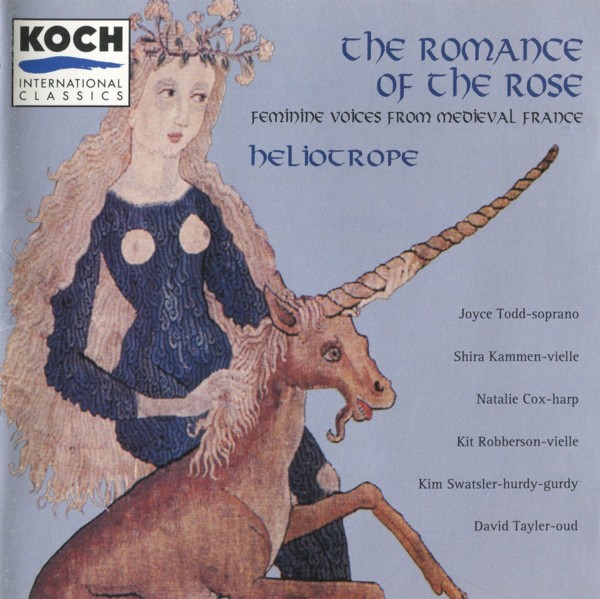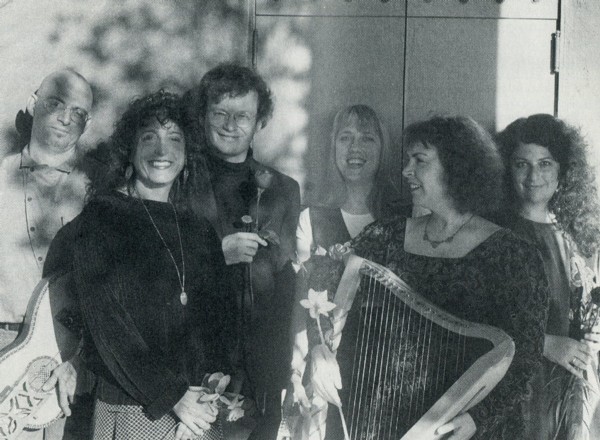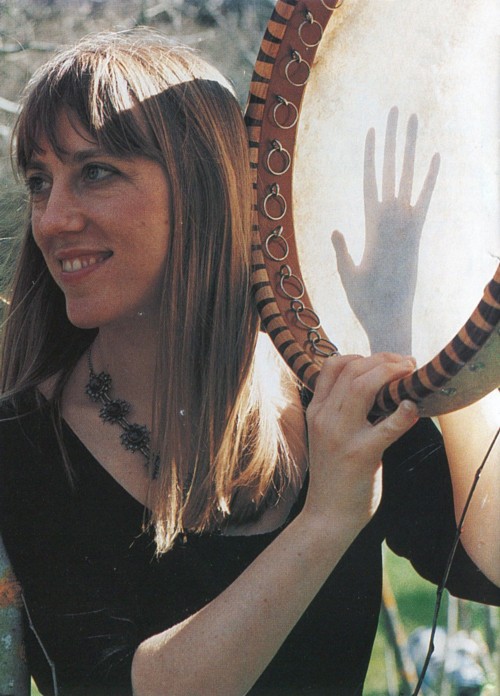
medieval.org
amazon.com
Koch International 7103
1995

medieval.org
amazon.com
Koch International 7103
1995
01 - Estampie Roine Blance [2:33]
adapted and arranged J. Todd
Cox, Kammen, Robberson, Todd
02 - A chantar m'er de so qu'ieu non volria
[8:31]
Trobairitz lyric: Contessa de DIE ca. 1200 Paris, Blb. Nat. MS
F.fr.844
Todd, Cox, Kammen, Swastler
03 - Three songs from Guillaume de Dole, The Romance of the Rose
Todd, Kammen [9:00]
a) Siet soit Bele Aye [1:54]
anon. 13th C; melody J. Todd
b) La Bele Doe siet au vent [3:38]
c) Quant revient la sesons [3:28]
anon. 13th C; melodies adapted from Gace BRULE
04 - Estampie Guiraut Riquier [2:36]
arranged J. Todd
Cox, Kammen, Robberson, Todd
05 - Per joi que d'amor m'avegna [10:10]
Trobairitz lyric: CASTELLOZA ca. 1200, New York, Morgan Library 819;
melody: Guiraut de BORNELH
Todd, Cox, Kammen, Robberson
06 - Bele Yolanz en ses chambres seoit
[4:57]
anon. chanson de toile, 13th C Paris, Bib. Nat. F. fr. 20050
Todd
07 - Bele Doette as fenestre se siet [9:30]
anon. chanson de toile, 13th C Paris, Bib. Nat. F. fr. 20050
Todd, Cox
08 - Estampie Marcabru [3:08]
Arr. J. Todd
Kammen, Tayler, Todd
09 - Estat ai en grue cossirier [4:18]
Trobairitz lyric: Contessa de DIE, Rome, Bib. Vat. 5232;
melody: Raimon de MIRAVAL
Todd
10 - Estampie Bele li gossi [3:41]
Arr. R. Whelden/S. Kammen
Cox, Kammen, Robberson, Todd
11 - Jherusalem, grant damage me fais [4:47]
anon. chanson de femme, 13th C. Paris, Bib. Nat. F. fr. 844;
melody: Gace BRULE
Todd, Kammen, Swastler
Heliotrope
Joyce Todd
Joyce Todd · soprano, percussion, harp
Natalie Cox · harp
Shira Kammen · vielle, rebec
Kit Robberson · vielle
Kim Swatsler · hurdy-gurdy, monochord
David Tayler · oud
Recorded at St. Vincent's School for Boys, San Rafael, CA
Mastered by Peter Nothnagle
#1 2 4 5 10:
Recorded July, 1995
Produced and engineered by Jack Vad.
#3 6 7 8 9 11:
Recorded November', 1995
Produced and engineered by David Tayler.

The Tradition
The poetic traditions of medieval France produced the first great
flowering of vernacular lyric poetry in Western Europe. This recording
features songs by the women troubadours or trobairitz from
southern France, and also women's songs or chansons de femme
from the trouvère tradition in the North. The songs of the trobairitz
were composed in Old Occitan (langue d'oc) while the anonymous
poets of the chansons de femme composed their songs in Old French (langue
d'oil). These repertoires, though composed in different languages
and regions, are two branches of the same tradition. In fact, the words
troubadour, trobairitz and trouvère are all
derived from the same Occitan root, "trobar," meaning "to compose, to
invent, to look for."
The troubadour tradition, of which the trobairitz and trouvères
are distinct parts, began as early as the 11 th century and continued
until the mid-13th century. This poetic and musical culture was not a
written culture; thus, the poems of the troubadours, trobairitz and
trouvères developed within an oral tradition, in some cases for
as long as 150 years before being anthologized in manuscripts in the
13th and 14th century. These manuscripts were compiled after the
tradition had for the most part ceased, and scholars are not sure
whether there were any previous written sources for the songs or
whether they were written down from memory by the scribes. The
troubadour tradition's long "prescribal" existence has been pieced
together by historians despite the scarcity of written evidence, and it
seems clear that the poets relied on memory as the primary means of
transmission of their works.
Though most written literary traditions value permanence, originality
and ownership, the troubadours, trobairitz, and trouvères could
not depend on a stable text since their works were likely to undergo
changes as they were learned and relearned by various singers. Poems
were learned by memory, and were commonly sent to an intended audience
via a "messenger" who was perhaps another poet or jongleur, a performer
who may have been in the employ of a poet or acting independently. The
presence of this oral tradition is evident in the fact that many of the
poems exist in different versions in several manuscripts. In the
troubadour tradition, singers who could improve upon a song were
celebrated while those who misunderstood the essence of a song, and
thereby corrupted it, were criticized. Troubadour scholar Amy Van Vleck
writes that this tradition depended on the interplay between "the
original poet, the performer (who recomposes), and the auditor (who
reconstructs the message in his mind) . . . [where] each new learner of
a song speaks partly with the voice of the original poet and partly
with his own voice."
The trobairitz repertory is unique in being the largest body of women's
lyric poetry to have been composed in the medieval period. The poems of
the sixteen trobairitz who are named in the manuscripts were composed
between 1170 and 1260, during the latter part of the troubadour
tradition. Much research has been directed in recent years toward the
status of women in medieval culture. Historians have documented that
women experienced a general decline in social position from the
10th to the 13th century, yet they have also shown that women did
temporarily recover several important legal rights during a period
roughly corresponding to the activities of the trobairitz. These
rights, to hold property, administer estates, and create wills, are
indications of a society which fostered the participation of noble
women in diverse aspects of medieval culture.
The comparatively large trobairitz repertory provides evidence that the
tradition of courtly love or fin amors in which these poets
worked did not exclude the participation of women. Women were not only
the objects of desire of the male poets, but also singers, jongleurs,
composers, and suitors in their own right. Marriages were not expected
to be accompanied by love, and, especially for women, were often
arranged for political expediency and at a very young age. In this
culture courtly love was more likely to be expressed outside the
boundaries of marriage. According to the conventions of courtly love, a
poet vows selfless service to a beloved, who was often the spouse of
another noble. These conventions can be viewed as a code of love which
served as the inspiration for poetry as an end in itself, as well as a
practical means to attain the object of desire.
The Songs
The two trobairitz represented on this recording, the Comtessa de Die
and Castelloza were active in the early 13th century. Though nothing is
known for certain of their lives or identities, their poems present two
highly individualized voices within the trobairitz repertory. The
Comtessa de Die's "I must sing of that which I would rather not" (A
chantar m'er de so qu'ieu non volria) laments the singer's betrayal
of her loved one, while at the same time reminding her lover and her
audience of her fine qualities as a beautiful and courtly woman. This
same confident tone, which combines lamentation with a declaration of
self-worth, is maintained in the Comtessa's "Lately I have been in
great distress" (Estat ai en greu cossirier). In this seduction
song, the singer, having loved to excess (sobrier), describes
the pleasure her chevalier would feel if she let him lean his head
against her breast, and hold him in her bare arms (bratz nut).
In the last verse she makes the conditions of the seduction clear when
she says: "I would gladly have you in my husband's place, if you would
swear to do my bidding." In contrast to the Comtessa's pride, the poems
of Castelloza reveal a suitor who feels powerless to succeed in
attaining the object of her desires. In the song, "For the joy that
comes to me from love, I'll no longer care to rejoice" (Per joi que
d'amor m'avenga) the singer seems to relish the defeats of love,
thanking her beloved even for her sufferings, for these are all that
she receives from him. Castelloza's songs give voice to a deep despair
that has earned her the title of "dark lady" of medieval song, and, in
her own time, her finely crafted poems brought her honor and stature as
a trobairitz.
Many of the women's songs from the North were chansons de toile,
sometimes translated as "spinning songs," in reference to the activity
which occupied women throughout the year, the spinning of yarn for
weaving. These chansons are romantic narratives which tell the
stories of female protagonists, who are usually of noble origins. The
songs typically begin by naming the heroine: bele Doette, bele Yolanz
or bele Aye; they then describe what she is doing: sitting by the
window, sewing or reading a book. Such formulaic beginnings introduce a
great variety of narratives, some tragic, some seductive, and some
humorous. Bele Doette narrates the story of a young woman whose
husband Doon is away at a tournament. Such tournaments were popular
peacetime opportunities for knights to practice their battle skills.
Knights could benefit financially by capturing their competitors, and
these contests were not infrequently fatal. In the song, a messenger
arrives to tell Doette the news that Doon was killed while jousting.
Doette's grief prompts her to become the powerful abbess of an abbey
which she builds for those who suffer from love. The song's beautiful,
repetitive melody and plaintive refrain express Doette's lament. Bele
Yolanz, sounding a lighter note, describes the meeting of two
lovers after a long separation. This song ends happily, for the lovers
"lie together, in the French manner, upon a fine bed."
The third source of songs for the present recording is the important
13th-century romance by Jean Renart: The Romance of the Rose or
Guillaume de Dole (not to be confused with the better-known Romance
of the Rose written by Guillaume de Lorris.) The "rose" of the
title refers not to the flower but to the heroine Lïenor's
birthmark, "the great marvel of the crimson rose on her soft white
thigh." In this story, Conrad, the King of Germany, falls in love with
Lïenor, sister to the gallant and brave knight Guillaume de Dole,
who has become the king's best friend. However, a jealous vassal (seneschal)
of the king, who fears his privileges will be usurped by Guillaume,
plots to ruin Lïenor's honor, and tricks her mother into telling
him about the "rose" on her thigh. The seneschal then claims to
have "deflowered" Lïenor, using the intimate knowledge he has
pried from her mother. Lïenor is thought guilty by all, including
her brother Guillaume, but through an ingenious plan, she manages to
outsmart the seneschal, prove her innocence, and marry the
king. Besides being of great interest to feminist literary scholars,
the Romance is important as a document of early 13th century
culture, diet and dress. It is also a unique source for medieval
chansons which are skilfully woven into the fabric of the narrative.
The present recording includes two chansons de toile sung in
the Romance by the heroine Lïenor, and a
trouvère song-fragment sung by a jongleuresse introduced as "the
beautiful Doette from Troyes."
The Music
The poems of the trobairitz and the chansons de toile have survived
almost entirely without melodies. This situation is not unusual since
out of all the songs in the medieval manuscripts, less than one tenth
appear with musical notation. When melodies do accompany the poems, the
notation does not, as far as we know, indicate rhythm, nor does it give
any indication of meter, tempo, or accompaniment. I have drawn on
melodies from contemporaneous manuscripts to create settings for these
poems, a solution which is fully consistent with the medieval
predilection for borrowing, adapting, and copyrighting from existing
sources. The instrumental accompaniments and the instrumental dances
have been created using medieval forms as guidelines, though they are
nevertheless a modern musician's contribution to the repertory. Perhaps
in this performance we can assume a place in the troubadour tradition
by speaking partly with the voices of the original poetesses, and
partly with our own.
© 1995, Joyce E. Todd
University of Pennsylvania
